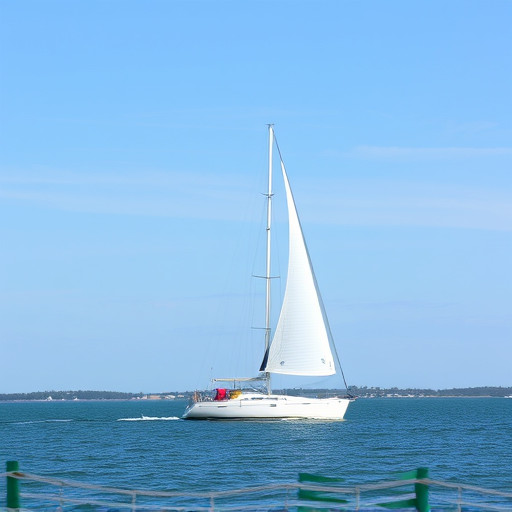TL;DR:
– Sailboat Operation Fundamentals: Sailing harnesses wind power through sails, requiring understanding of sail shapes, wind reading, and adjusting sail positioning. Key components include rudders, keels, and winches for steering, stability, and line control. Sailboat types vary from small dinghies to large yachts, each with unique features.
– Sailboat Components: A sailboat consists of a hull (for buoyancy), mast (supports sails), various sail types (like gaff and jibs), a rudder (for steering), deck gear, living quarters, and a cockpit (command center). These work together to navigate using natural wind power.
Sailboats have captivated adventurers and enthusiasts for centuries, offering a unique blend of grace, power, and freedom on the open sea. This article delves into the fascinating world of sailboats, exploring their operation, design, and the art of navigation. From understanding the fundamentals of wind-driven travel to discovering diverse sailboat types catering to various needs, we’ll chart a course through essential knowledge for anyone interested in this timeless maritime pursuit. Whether you’re an aspiring sailor or simply curious about the open waters, this guide promises an enlightening journey.
- Understanding the Fundamentals of Sailboat Operation
- – Definition and basic principles of sailing
- – Components of a sailboat: Hull, mast, sails, rudder, and deck
Understanding the Fundamentals of Sailboat Operation

Understanding the fundamentals of sailboat operation is crucial for anyone venturing onto the water. At its core, a sailboat harnesses wind power through sails to propel itself across bodies of water. The basic principles involve leveraging the wind’s kinetic energy and using it to create forward motion. Sails come in various shapes and sizes, each designed to optimize performance based on different wind conditions and sailing techniques. Knowing how to read the wind and adjust sail positioning is a skill that comes with practice, enabling sailors to navigate effectively and safely.
Beyond sail manipulation, sailboat operation encompasses an understanding of key components like rudders for steering, keels for stability, and winches for controlling lines. Effective control of these elements allows sailors to maneuver their vessels efficiently, maintain balance, and ensure a smooth sailing experience. Familiarity with different types of sailboats—from small dinghies to large yachts—is also essential, as each design offers unique advantages and challenges, catering to various sailing styles and purposes.
– Definition and basic principles of sailing

Sailing is an ancient art and sport that harnesses the power of wind to propel boats across bodies of water. At its core, it involves understanding and utilizing the natural elements—wind and water—to navigate a vessel without the need for an engine. The basic principle revolves around using sails, which are fabric or synthetic material designed to capture and convert the kinetic energy of the wind into forward motion. By adjusting the sails’ shape, angle, and tension, sailors can control the boat’s direction and speed.
The primary goal is to keep the sailboat moving in the desired path while utilizing the least amount of effort. Skilled sailors predict wind patterns and adjust their sail configurations accordingly, enabling them to “catch” the wind optimally. This involves various techniques such as tacking (changing course across the wind) and jibing (turning the boat end-on into the wind). Through these maneuvers, sailors can navigate along or even against the wind’s direction, making sailing both a challenging sport and an efficient means of transportation.
– Components of a sailboat: Hull, mast, sails, rudder, and deck

A sailboat is a marvel of marine engineering, composed of several key components that work in harmony to harness the power of wind. At its core lies the hull, which provides buoyancy and stability, keeping the boat afloat while protecting it from the elements. The mast stands tall, bearing the sails that capture the wind’s energy, converting it into forward thrust. These sails come in various types, each designed for different conditions and manouvres, from large gaff sails to smaller jibs.
Complementing the sail setup is the rudder, a critical steering mechanism allowing the boat to change direction. Located at the rear, the rudder is controlled by the sailor via a tiller or wheel, enabling precise navigation. On top of the hull, the deck offers space for sailing gear, living quarters, and often, a cockpit where sailors can command their vessel with confidence. These elements combine to create a vessel capable of gracefully gliding across the water’s surface, powered solely by nature’s breeze.
In conclusion, sailboats harness the power of wind through various types, each suited for different voyages. From sleek racing yachts to robust cruising boats, understanding their fundamental operation and unique features empowers enthusiasts to navigate both calm waters and challenging seas with grace and skill. Whether for recreation or adventure, sailing remains a captivating blend of art and science that connects us to the ancient maritime traditions while offering a distinctively peaceful way to explore our oceans.
